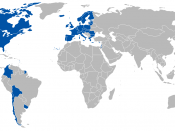Q2 (A) Explain why free international trade can be good for countries' economies; and examine the attempts to reduce trade barriers in the past decade (maximum 1,000 words)
'Free trade is the ability to undertake economic transactions with people in other countries free from any restraints imposed by governments or other regulators'. (Economist, 2013)
Selected forms of FTA | Description | Example |
Bilateral Trade | Reduces trade barriers between 2 participating nations | Singapore - China Singapore - USA |
Regional Trade Groups (may take form of preferential trade) | Reduces trade barriers between participating member states | European Union ASEAN |
Multilateral Agreements | Reduces trade barriers between many participating member countries | WTO (~150 member countries) |
Free international trade can help countries to:
Specialize and trade based upon comparative advantages
Decrease costs by capitalizing on economies of scale
Encourage efficiency in the market through increased competition
Stimulate export growth etc
To better understand the practical implications of FTAs, the country case example of Singapore and its FTA with China and USA have been used:
CSFTA:
Singapore-China FTA was signed after eight rounds of negotiations and was concluded on September 3 in Beijing.
Realized Benefits:
Engine of Growth:
Particulars | CFSTA | Benefits to Importers |
Tariff Elimination | 95% of Products entering China | Tariff free Importing |
Rules of Origin (ROO)* | Wholly Obtained; Exclusive Product Specific Rule; Regional Value Content not less than 40% of FOB | Access to wide range of products eligible for preferential treatment |
Third Party Invoicing | Yes | Originating products still qualify for preferential treatment even if the invoices for these goods were issued in third countries |
* The discriminatory ROO's and tariff rates under different FTA's leads to complications in FTA and is commonly known as 'Spaghetti Bowl Effect'. It is also known as 'Noodle Effect' with respect to Asian Countries. |
The above key facilitative commitments made more...


